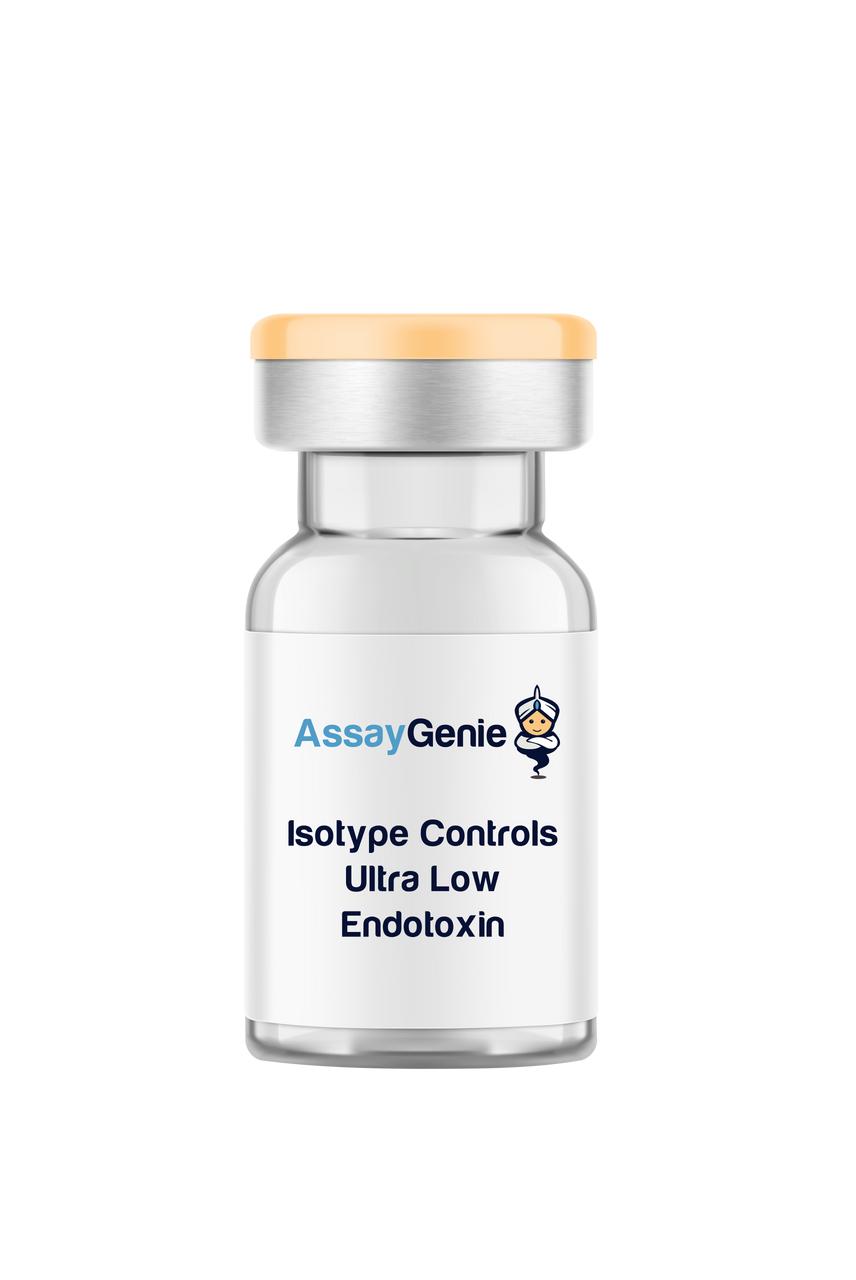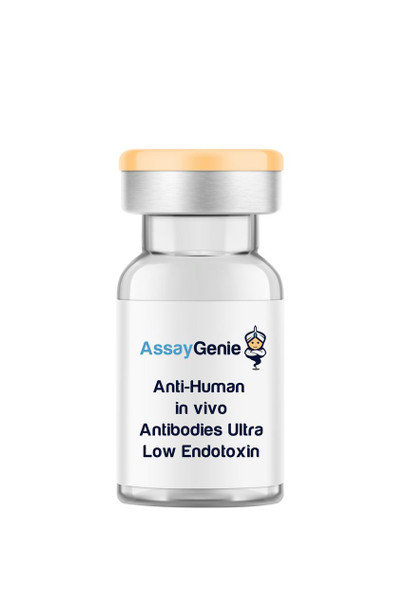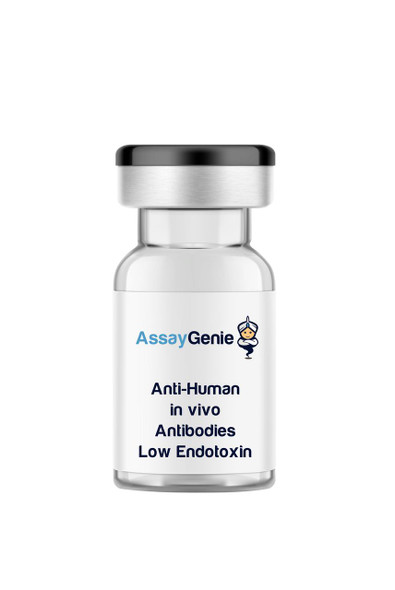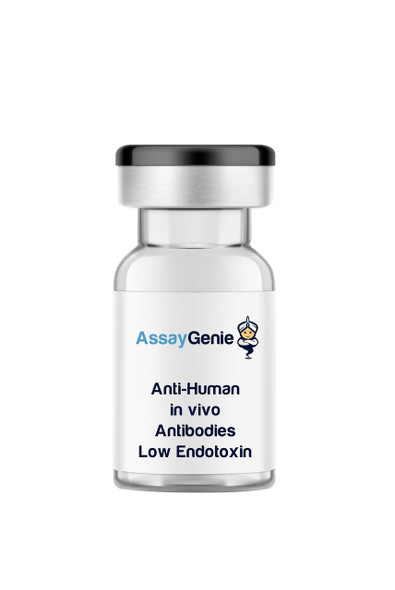Anti-Human HLA-DR (MHC Class II) In Vivo Antibody - Ultra Low Endotoxin (IVMB0021)
- SKU:
- IVMB0021
- Antibody Type:
- Functional-Grade In Vivo Antibody
- Applications:
- In Vivo
- Disease Area:
- Cancer
- Clone:
- L243
- Protein:
- HLA-DR
- Isotype:
- Mouse IgG2a
- Reactivity:
- Baboon
- Chimpanzee
- Cynomolgus Monkey
- Marmoset
- Rhesus Monkey
- Squirrel Monkey
- Canine
- Human
- Synonyms:
- Major Histocompatibility Class II
- MHC class II
- HLA-DR Monomorphic
- Endotoxin Level:
- Ultra Low Endotoxin
- Host Species:
- Mouse
- Blocking
- CODEX
- CyTOF
- Depletion
- FC
- IHC FF
- IP
- WB
Description
Anti-Human HLA-DR (MHC Class II) In Vivo Antibody - Ultra Low Endotoxin
Introducing the Anti-Human HLA-DR (MHC Class II) In Vivo Antibody - Ultra Low Endotoxin from Assay Genie, a highly specific monoclonal antibody meticulously crafted for in vivo applications. This antibody is designed to target the HLA-DR protein, a critical component of the MHC Class II molecule complex involved in antigen presentation and immune response, making it an invaluable tool for research in immunology and related disciplines.
With a mouse IgG2a, lambda isotype, it guarantees high purity and ultra-low endotoxin levels (<0.01 EU/µg), making it exceptionally suited for sensitive applications such as ELISA, flow cytometry, and immunohistochemistry. Available in various sizes, this antibody is formulated in phosphate-buffered saline, ensuring maximum stability and efficacy. HLA-DR is a protein complex expressed on antigen-presenting cells, including B lymphocytes, dendritic cells, and macrophages. It plays an essential role in the immune system by presenting processed peptide antigens to T-helper cells, thus initiating an immune response. Enhance your research with the reliability and versatility offered by this premium quality antibody.
| Product Name: | Anti-Human HLA-DR (MHC Class II) In Vivo Antibody - Ultra Low Endotoxin |
| Product Code: | IVMB0021 |
| Size: | 1mg, 5mg, 25mg, 50mg, 100mg |
| Clone: | L243 |
| Protein: | HLA-DR |
| Product Type: | Monoclonal Antibody |
| Synonyms: | Major Histocompatibility Class II, MHC class II, HLA-DR Monomorphic |
| Isotype: | Mouse IgG2a |
| Reactivity: | Baboon, Chimpanzee, Cynomolgus Monkey, Marmoset, Rhesus Monkey, Squirrel Monkey, Canine, Human |
| Immunogen: | Unknown |
| Applications: | B, CyTOF®, Depletion, FC, IHC FF, IP, PhenoCycler®, WB |
| Formulation: | This monoclonal antibody is aseptically packaged and formulated in 0.01 M phosphate buffered saline (150 mM NaCl) PBS pH 7.2 - 7.4 with no carrier protein, potassium, calcium or preservatives added. |
| Endotoxin Level: | <0.5 EU/mg as determined by the LAL method |
| Purity: | ≥98% monomer by analytical SEC >95% by SDS Page |
| Preparation: | Functional grade preclinical antibodies are manufactured in an animal free facility using only In vitro protein free cell culture techniques and are purified by a multi-step process including the use of protein A or G to assure extremely low levels of endotoxins, leachable protein A or aggregates. |
| Storage and Handling: | Functional grade preclinical antibodies may be stored sterile as received at 2-8°C for up to one month. For longer term storage, aseptically aliquot in working volumes without diluting and store at -80°C. Avoid Repeated Freeze Thaw Cycles. |
| Applications: | B, CODEX®, CyTOF®, Depletion, FC, IHC FF, IP, WB |
| Recommended Usage: | FC The suggested concentration for this HLA-DR (Clone L243) antibody for staining cells in flow cytometry is ≤ 0.5 µg per 106 in a volume of 100 µl or 100µl of whole blood. Titration of the reagent is recommended for optimal performance for each application. WB The suggested concentration for this HLA-DR (Clone L243) antibody for use in western blotting is 1-10 µg/ml. |
| Reactivity: | Baboon, Chimpanzee, Cynomolgus Monkey, Marmoset, Rhesus Monkey, Squirrel Monkey, Canine, Human |
| Host Species: | Mouse |
| Specificity: | Clone L243 recognizes a conformational epitope on the human MHC class II molecule HLA-DRα, which depends on the correct folding of the αβ heterodimer1. It does not cross-react with HLA-DP or HLA-DQ. |
| Antigen Distribution: | HLA-DR is expressed on antigen-presenting cells, including macrophages, monocytes, DCs, and B cells, and activated T cells. |
| Immunogen: | Unknown |
| Concentration: | ≥ 5.0 mg/ml |
| Endotoxin Level: | <0.5 EU/mg as determined by the LAL method |
| Purity: | ≥98% monomer by analytical SEC >95% by SDS Page |
| Formulation: | This monoclonal antibody is aseptically packaged and formulated in 0.01 M phosphate buffered saline (150 mM NaCl) PBS pH 7.2 - 7.4 with no carrier protein, potassium, calcium or preservatives added. |
| Preparation: | Functional grade preclinical antibodies are manufactured in an animal free facility using only In vitro protein free cell culture techniques and are purified by a multi-step process including the use of protein A or G to assure extremely low levels of endotoxins, leachable protein A or aggregates. |
| Storage and Handling: | Functional grade preclinical antibodies may be stored sterile as received at 2-8°C for up to one month. For longer term storage, aseptically aliquot in working volumes without diluting and store at -80°C. Avoid Repeated Freeze Thaw Cycles. |
HLA-DR antibody, clone L243, recognizes the major histocompatibility complex (MHC) class II molecule Human Leukocyte Antigen - DR isotype (HLA-DR). MHC class II is constitutively expressed on human professional antigen-presenting cells (APCs), including macrophages/monocytes, dendritic cells (DCs), and B cells, and is induced on T cells upon activation2. HLA-DR consists of two transmembrane proteins, a 35 kDa α (heavy) chain and 29 kDa β (light) chain3 encoded by the HLA-DRA and HLA-DRB1, HLA-DRB3, HLA-DRB4, and HLA-DRB5 genes, respectively, located in the HLA complex of chromosome 6. The N-terminal α1 and β1 domains form the antigen-binding groove, which binds 13-25 aa peptides derived from exogenous antigens4. On APCs, MHC class II plays a critical role in the adaptive immune response by presenting phagocytosed antigens to helper CD4 T cells. The T cell receptor (TCR)/CD3 complex of CD4 T cells interacts with peptide-MHC class II, which induces CD4 T cell activation leading to the coordination and regulation of other effector cells. CD4 molecules also bind to MHC class II, which helps augment TCR signaling5. It has also been demonstrated that MHC class II express on activated T cells are capable of antigen presentation6 and can transduce signals into T cells, enhancing T cell proliferation and activity7. HLA-DR expression is a marker of T cell activation and correlates with disease activity in patients with autoimmune disease8 and rapid progression in HIV infection9. Specific alleles of HLA-DR are associated with autoimmune diseases, including rheumatoid arthritis10.
| Technical Datasheet: | View |
| Protein: | HLA-DR |
| Function: | Peptide presentation |
| Ligand/Receptor: | CD3/TCR, CD4 |
| Research Area: | Immunology, Innate Immunity |

| Mouse IgG2a Isotype Control | |
|---|---|
| Clone | C1.18.4 |
| Isotype | Mouse IgG2a kappa |
| Endotoxin Level | Ultra Low Endotoxin |
Meet the team!
Shane Costigan
Territory Manager & Team Lead
Abdul Khadim
Sales Executive






